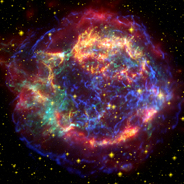Warped Light and Dark Matter
Video Player
Video Versions
Dive deeper into the enduring mysteries of dark matter.
Related scientific publication: https://science.sciencemag.org/content/369/6509/1347
Related news release: https://science.nasa.gov/missions/hubble/hubble-observations-suggest-a-missing-ingredient-in-dark-matter-theories/
Related scientific publication: https://science.sciencemag.org/content/369/6509/1347
Related news release: https://science.nasa.gov/missions/hubble/hubble-observations-suggest-a-missing-ingredient-in-dark-matter-theories/
Produced by the Space Telescope Science Institute, Office of Public Outreach.
Writing: Leah Ramsay
Design: Joe Olmsted
Science review lead: Dr. Kelly Lepo
Education lead: Holly Ryer
Special thanks to: Timothy Rhue II and Dr. Christopher Britt
Music from APM Music
(SPEECH)
[DOWNBEAT MUSIC]
[DOWNBEAT MUSIC]
(DESCRIPTION)
galaxies spin brightly in black space
galaxies spin brightly in black space
Where do we fit in all this?
What is out there?
How does the universe work?
After millennia of studying the stars, we have learned a lot about the universe.
and our place within it.
We've also learned how much we don't know.
Astronomers say that everything we've seen makes up only 5% of the content of the universe.
Everything else is dark to us, unseen and unknown. Matter that cannot be directly detected with telescopes is called dark matter.
How do we know dark matter exists?
Telescopes have seen evidence of dark matter by indirect detection by observing how dark matter's mass affects the space and normal matter around it.
Groupings of large galaxies, galaxy clusters, are the largest gatherings of mass in the universe. Most of that mass is dark matter.
The cluster is so massive that it warps the fabric of space.
The arcs of light are distant galaxies behind the cluster.
Warped space within the cluster magnifies but distorts distant galaxies.
This effect of light passing through warped space is called gravitational lensing.
We see the effects of dark matter, but not the cause.
Like other scientists, astronomers look for the causes of what we observe.
Astronomers make predictions with calculations and computer simulations.
Engineers build telescope instruments that can test predictions. and see if they match up with what we see happening in the universe.
Recent observations with NASA's Hubble Space Telescope and the European Southern Observatory's Very Large Telescope in Chile show surprising results about dark matter.
The telescope observations do not match the predictions. Not even close.
Within sample galaxy clusters, individual galaxies exhibit lensing that is 10 times stronger than expected. This is a big difference between prediction and observation.
It seems that with dark matter, we may be even more in the dark than we thought.
In science, realizing what you don't know is not a bad thing.
It can be "far more interesting" to not find what you are looking for, and instead find something unexpected. Theoretical astrophysicist, Stephen Hawking.
It can be the first step toward discovery.
What could the unexpectedly strong gravitational lensing mean?
It could be that the computer models and simulations need adjusting.
Or, it could mean that something is missing form our general understanding of the physics of the universe, and theories need to be revised.
Astronomers are following up on this discovery, looking at more galaxy clusters and their gravitational lensing, seeking to learn the nature of dark matter, and how much more we still have to discover about our universe.

